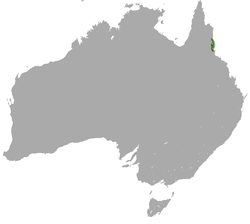Lumholtz tree kangaroo
| Lumholtz tree kangaroo | ||||||||||||
|---|---|---|---|---|---|---|---|---|---|---|---|---|

Lumholtz tree kangaroo ( Dendrolagus lumholtzi ) |
||||||||||||
| Systematics | ||||||||||||
|
||||||||||||
| Scientific name | ||||||||||||
| Dendrolagus lumholtzi | ||||||||||||
| Collett , 1884 |
The Lumholtz tree kangaroo ( Dendrolagus lumholtzi ) is a species from the kangaroo family . The species is named after the Norwegian naturalist and ethnologist Carl Sophus Lumholtz . Along with the Bennett tree kangaroo ( Dendrolagus bennettianus ), it is one of two tree kangaroo species found in Australia. The indigenous name of the Aborigines is Boongarry.
description
The Lumholtz tree kangaroo is between 110 and 130 centimeters tall. The round and cylindrically shaped tail makes up more than half of the total length. It serves as a balancing and control organ. The males grow larger and heavier than the females. The hind legs are much more strongly developed than those of the ground-dwelling kangaroos. The front legs are almost the same length as the rear legs. The head is small and slightly triangular in shape with a pointed snout. The ears are extremely small and rounded. The fur is colored brown to dark brown or even black. The chest and belly sides are light cream in color.
Way of life
The Lumholtz tree kangaroo is nocturnal. It spends most of its life in trees. It can jump from a tree to the ground from a height of a few meters without injuring itself. The strong rear legs serve as a spring. During the day it sits huddled in the branches and sleeps. At dusk it becomes active and searches for food. It holds on to branches with both its hind legs and its front legs. The Lumholtz tree kangaroo mostly lives solitary. Small feeding communities of no more than four specimens could be observed. Sexually mature males meet each other very aggressively and sometimes fight each other until the death of one of the opponents.
distribution
The Lumholtz tree kangaroo lives in Australia in the tropical rainforest of northern Queensland . There its relatively small distribution area is limited to the Atherton plateau .
nutrition
The Lumholtz tree kangaroo is a pure herbivore . It feeds on leaves and fruits. Sometimes there is also foraging in maize and grain fields.
Reproduction
Female Lumholtz tree kangaroos reach sexual maturity at a little over two years at the earliest, males at around four and a half years. The mating season is all year round. After a gestation period of 47 to 64 days, the female gives birth to a young animal. The young animal is about two centimeters tall and one to two grams in weight. The young animal crawls from the birth canal into the pouch and sucks on one of the four teats. It looks out of the pouch for the first time in five months. It leaves the pouch for the first time after 246 to 275 days. The pups are weaned after a further 87 to 240 days and leave the mother. Lumholtz tree kangaroos can live up to eight years. Up to now no specimen has survived its youth in zoological gardens. Studies on reproductive biology took place in spacious open-air enclosures in their natural habitat.
literature
- Ronald M. Nowak: Walker's Mammals of the World , Johns Hopkins University Press, 1999.
- Maxwell, S. Burbidge, AA & KD Morris (1996): Action Plan for Australian Marsupials and Monotremes . Wildlife Australia, Canberra.
- Newell, GR (1999): Responses of Lumholtz's tree-kangaroo (Dendrolagus lumholtzi) to loss of habitat within a tropical rainforest fragment . Biological Conservation, 91: 181-189.
swell
- Bowyer, JC, Newell GR & MDB Eldridge M. (2002): Genetic effects of habitat contraction on Lumholtz's tree-kangaroo (Dendrolagus lumholtzi) in the Australian Wet Tropics . Conservation Genetics, 3 (1): 59-67.
- Johnson, PM & D. Steven (2003): Reproduction of Lumholtz's tree-kangaroo, Dendrolagus lumholtzi (Marsupialia: Macropodidae) in captivity, with age estimation and development of the pouch young . Wildlife Research, 30 (5): 505-512.
